Monitoring the Internet Agent through the Server Console
The Internet Agent console is displayed on the NetWare® server, the Windows server, or Linux where the Internet Agent is running. If the Internet Agent is running as a Windows service under the Local System User, it is displayed on the desktop only if the Allow Service to Interact with Desktop option was selected during installation or has been configured on the Internet Agent service's General property page.
The Internet Agent console on a Windows server is shown below. The console on a NetWare or Linux server displays the same information.
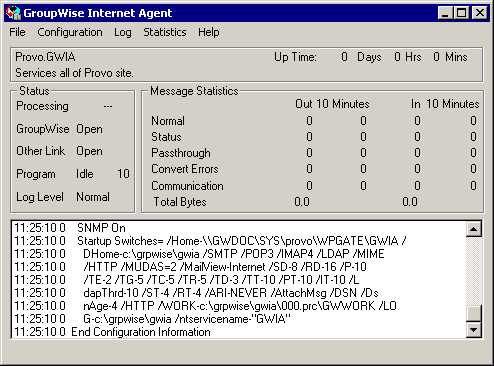
Refer to the following sections for information about the specific sections and functionality included in the console:
Description
The description section of the console, shown below, identifies the Internet Agent and displays how long its has been running.
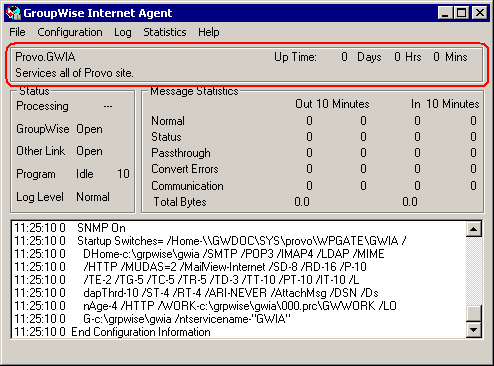
Domain.Gateway: Displays the domain and Internet Agent names.
Up Time: Displays the total length of time the Internet Agent has been running. If the Internet Agent terminates unexpectedly (such as in a power outage), the Up Time display will not reset to 0. It will show the total time elapsed since the Internet Agent was last loaded after a proper termination.
Description: Displays any descriptive information provided on the Internet Agent object's Identification page (Internet Agent object > GroupWise tab > Identification page).
Status
The Status section of the console, shown below, provides a quick look at the Internet Agent's current message processing activity, network connectivity, and information logging level.
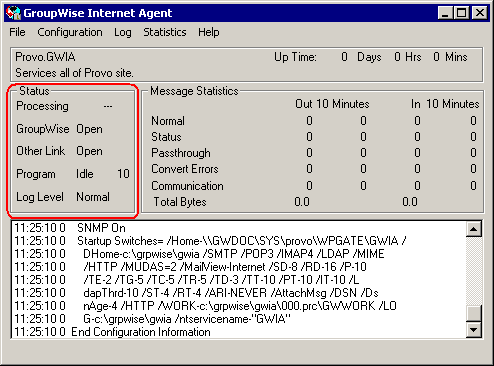
Processing: Displays a rotating bar if the Internet Agent is running. If there is no bar, or if the bar is stationary for more than one minute, the Internet Agent is not running.
GroupWise: Displays whether the Internet Agent's network connection is OPEN or CLOSED. This network connection is the Internet Agent's only link to GroupWise. The status indicates whether or not the Internet Agent can write to the wpcsin directory and access the wpcsout directory. The Internet Agent does a scan each cycle to see if these directories exist. If the status is CLOSED, the Internet Agent will attempt to reattach to the network.
It is normal for this field to display the word CLOSED for a minute or so after you start the Internet Agent. However, if the connection remains CLOSED, look for the wpcsin and wpcsout directories. If they are not created yet, start the Message Transfer Agent.
Other Link: This field does not apply to the Internet Agent. It will always say OPEN.
Program: Displays the processing cycle. You can use the Gateway Time Settings page (Internet Agent object > GroupWise tab > Gateway Time Settings page) to adjust the processing cycle.
Log Level: Displays the logging level the Internet Agent is currently using. The logging level determines how much data is displayed on the message portion of this screen and written to the log file. You can use the console menu options to override the default setting for the current session. For information, see Logging
Statistics
The Statistics section of the console can display five different sets of information:
- Message Statistics
- SMTP Service Statistics
- POP Service Statistics
- IMAP Service Statistics
- LDAP Service Statistics
Message Statistics
The Message Statistics section of the console, shown below, is the default statistics section displayed by the Internet Agent console.
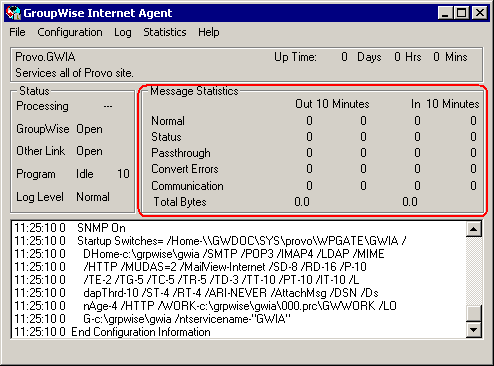
The Message Statistics shows the number of inbound and outbound messages processed by the Internet Agent. The Out and In columns display the cumulative message totals while the 10 Minutes columns display snap shot totals for the last ten minutes. You change the time interval of the 10 Minutes column in ConsoleOne. For instructions, see Increasing Polling Time.
Normal: Displays the number of inbound and outbound messages processed by the Internet Agent.
Status: Displays the number of inbound and outbound status messages processed by the Internet Agent. The amount of status message traffic depends on the Outbound Status level (ConsoleOne > Internet Agent object > GroupWise tab > Optional Gateway Settings page). If the Outbound Status level is set to Full, more status messages are generated. If the Outbound Status level is set to Undelivered, fewer status messages are generated.
Passthrough: Displays the number of inbound and outbound passthrough messages the Internet Agent has processed.
Convert Errors: Outbound messages are converted from GroupWise® format to MIME or RFC-822 format. Inbound messages are converted to GroupWise format. This field displays the number of inbound and outbound messages that the Internet Agent could not convert.
Communication: Displays the number of communication errors encountered by the Internet Agent.
Total Bytes: Displays the total number of bytes of inbound and outbound messages processed by the Internet Agent.
SMTP Service Statistics
The SMTP Service Statistics section, shown below, includes only the information for messages processed by the Internet Agent's SMTP daemon.
In the NetWare Internet Agent's console, press F10-Options, then F9-Stats to switch to the SMTP Service Statistics.
In the Windows Internet Agent's console, select the Statistics menu, then click SMTP Service.
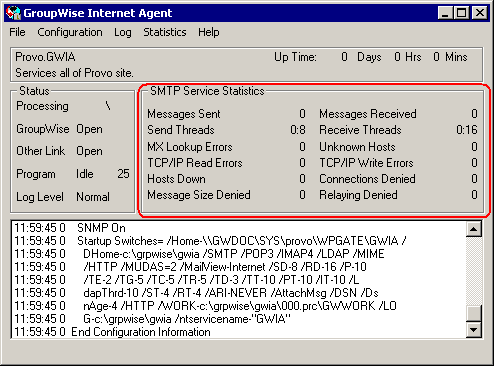
Messages Sent: Displays the total number of SMTP messages sent by the Internet Agent during its current up time.
Send Threads: The first number displays the number of threads currently being used to send SMTP messages. The second number displays the number of threads still available to the Internet Agent for sending SMTP messages. This will be the total number of assigned send threads (by default, 8) minus the currently used threads. You can change the total number of assigned SMTP send threads in ConsoleOne (Internet Agent object > SMTP/MIME tab > Settings page). For more information, see Configuring Basic SMTP/MIME Settings.
Messages Received: Displays the total number of SMTP messages received by the Internet Agent during its current up time.
Receive Threads: The first number is the number of threads currently being used to receive SMTP messages. The second number is the number of threads still available to the Internet Agent for receiving SMTP messages. This will be the total number of assigned receive threads (by default, 16) minus the currently used threads. You can change the total number of assigned SMTP receive threads in ConsoleOne (Internet Agent object > SMTP/MIME tab > Settings page). For more information, see Configuring Basic SMTP/MIME Settings.
MX Lookup Errors: To resolve hostnames to IP addresses, the Internet Agent performs MX record lookups in DNS. This field displays the number of MX record lookups that failed.
Unknown Hosts: Displays the number of SMTP hosts that the Internet Agent could not establish a connection with because the hostname could not be resolved to an IP address.
TCP/IP Read Errors: Displays the number of TCP read errors encountered by the Internet Agent. A TCP read error occurs if the Internet Agent connects successfully to another SMTP host but is unable to process a TCP read command during the message transfer.
TCP/IP Write Errors: Displays the number of TCP write errors encountered by the Internet Agent. A TCP write error occurs if the Internet Agent connects successfully to another SMTP host but is unable to process a TCP write command during the message transfer.
Hosts Down: Displays the number of SMTP hosts that the Internet Agent could not establish a connection with in order to send or receive messages. The Internet Agent was able to resolve the hostname to an IP address, but the connection could not be established.
Connections Denied: Displays the number of connections denied by the Internet Agent. A connection will be denied if the host is blocked through:
- A Class of Service (ConsoleOne > Internet Agent object > Access Control tab > Settings page). For more information, see Controlling User Access.
- A blacklist (ConsoleOne > Internet Agent object > Access Control tab > Blacklists page). For more information, see Blocking Unwanted E-Mail.
- The Reject Mail if Sender's Identity Cannot Be Verified setting (ConsoleOne > Internet Agent object > SMTP/MIME tab > Security Settings page), if it is enabled and the sender's identity can not be verified. For more information, see Protecting Against Unidentified Hosts and Mailbombs (Spam).
Message Size Denied: Displays the number of SMTP messages that the Internet Agent would not send or receive because they exceeded the maximum message size. You can change the maximum message size in ConsoleOne (Internet Agent object > Access Control tab > Settings page > edit class of service > SMTP Incoming tab or SMTP Outgoing tab). For more information, see Controlling User Access.
Relaying Denied: Displays the number of relay messages denied by the Internet Agent. A relay message will be denied for the following reasons:
- The Internet Agent is not enabled as a relay host (ConsoleOne > Internet Agent object > Access Control tab > SMTP Relay Settings). For more information, see Enabling SMTP Relaying.
- The relay message could not be authenticated.
POP Service Statistics
The POP Service Statistics section, shown below, provides information about the POP activity handled by the Internet Agent.
In the NetWare Internet Agent's console, press F10-Options, then F9-Stats to switch to the POP Service Statistics.
In the Windows Internet Agent's console, select the Statistics menu, then click POP Service.
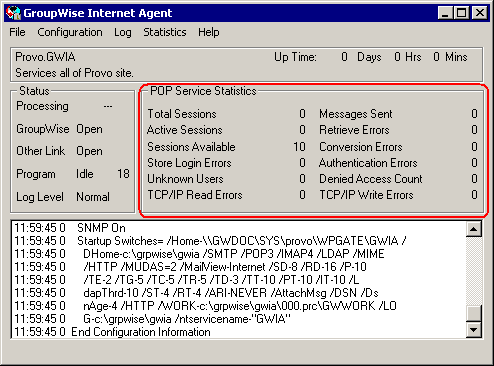
Total Sessions: Displays the total number of POP3 sessions processed by the Internet Agent during its current up time.
Active Sessions: Displays the number of currently active POP3 sessions.
Sessions Available: Displays the number of threads still available to the Internet Agent for POP3 sessions. This will be the total number of assigned POP3 threads (by default, 10) minus the active sessions. You can change the total number of assigned POP3 threads in ConsoleOne (Internet Agent object > POP3/IMAP4 tab > Settings page). For more information, see Configuring POP3/IMAP4 Services.
Messages Sent: Displays the total number of GroupWise mailbox messages retrieved through POP3 sessions.
Retrieve Errors: Displays the number of errors generated because the Internet Agent could not transfer messages to the POP3 client.
Conversion Errors: Displays the number of errors generated because the Internet Agent could not convert retrieved GroupWise messages to MIME format.
Store Login Errors: Displays the number of GroupWise user logins that failed because the users' GroupWise mailboxes were unavailable (for example, the post office is down or the Internet Agent link to the post office is down).
Authentication Errors: Displays the number of GroupWise user logins that failed because the user supplied an incorrect password.
Unknown Users: Displays the number of user logins that failed because the user does not exist in the GroupWise system.
Denied Access Count: Displays the number of POP3 sessions that were denied because the user does not have POP3 access. POP3 access is controlled through the user's Class of Service assignment (ConsoleOne > Internet Agent object > Access Control tab > Settings page). For more information, see Controlling User Access.
TCP/IP Read Errors: Displays the number of TCP read errors encountered by the Internet Agent. A TCP read error occurs if the Internet Agent successfully opens a POP3 session but is unable to process a TCP read command during the session.
TCP/IP Write Errors: Displays the number of TCP write errors encountered by the Internet Agent. A TCP write error occurs if the Internet Agent successfully opens a POP3 session but is unable to process a TCP write command during the session.
IMAP Service Statistics
The IMAP Service Statistics section, shown below, provides information about the IMAP activity handled by the Internet Agent.
In the NetWare Internet Agent's console, press F10-Options, then F9-Stats to switch to the IMAP Service Statistics.
In the Windows Internet Agent's console, select the Statistics menu, then click IMAP Service.
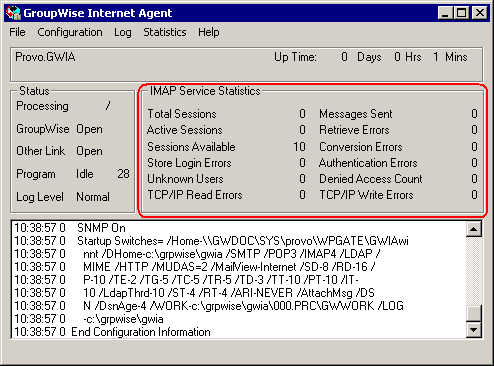
Total Sessions: Displays the total number of IMAP4 sessions processed by the Internet Agent during its current up time.
Active Sessions: Displays the number of currently active IMAP4 sessions.
Sessions Available: Displays the number of threads still available to the Internet Agent for IMAP4 sessions. This will be the total number of assigned IMAP4 threads (by default, 10) minus the active sessions. You can change the total number of assigned IMAP4 threads in ConsoleOne (Internet Agent object > POP3/IMAP4 tab > Settings page). For more information, see Configuring POP3/IMAP4 Services.
Messages Sent: Displays the total number of GroupWise mailbox messages retrieved through IMAP4 sessions.
Retrieve Errors: Displays the number of errors generated because the Internet Agent could not transfer messages to the IMAP4 client.
Conversion Errors: Displays the number of errors generated because the Internet Agent could not convert retrieved GroupWise messages to MIME format.
Store Login Errors: Displays the number of GroupWise user logins that failed because the users' GroupWise mailboxes were unavailable (for example, the post office is down or the Internet Agent link to the post office is down).
Authentication Errors: Displays the number of GroupWise user logins that failed because the user supplied an incorrect password.
Unknown Users: Displays the number of user logins that failed because the user does not exist in the GroupWise system.
Denied Access Count: Displays the number of IMAP4 sessions that were denied because the user does not have IMAP4 access. IMAP4 access is controlled through the user's Class of Service assignment (ConsoleOne > Internet Agent object > Access Control tab > Settings page). For more information, see Controlling User Access.
TCP/IP Read Errors: Displays the number of TCP read errors encountered by the Internet Agent. A TCP read error occurs if the Internet Agent successfully opens a IMAP4 session but is unable to process a TCP read command during the session.
TCP/IP Write Errors: Displays the number of TCP write errors encountered by the Internet Agent. A TCP write error occurs if the Internet Agent successfully opens an IMAP4 session but is unable to process a TCP write command during the session.
LDAP Service Statistics
The LDAP Service Statistics section, shown below, provides information about the LDAP activity handled by the Internet Agent.
In the NetWare Internet Agent's console, press F10-Options, then F9-Stats to switch to the LDAP Service Statistics.
In the Windows Internet Agent's console, select the Statistics menu, then click LDAP Service.
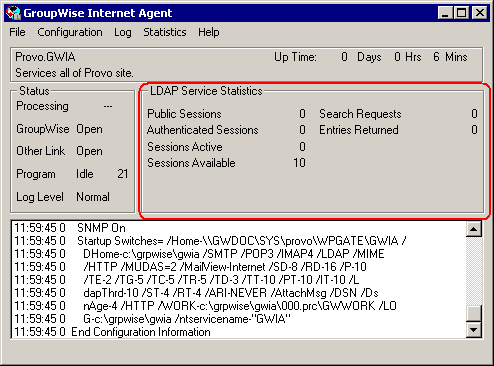
Public Sessions: Displays the total number of LDAP sessions handled by the Internet Agent.
Authenticated Sessions: This field is not used.
Sessions Active: Displays the total number of LDAP sessions currently being processed by the Internet Agent.
Sessions Available: Displays the number of threads still available to the Internet Agent for LDAP sessions. This will be the total number of assigned LDAP threads (by default, 10) minus the active sessions. You can change the total number of assigned LDAP threads in ConsoleOne (Internet Agent object > LDAP tab > Settings page). For more information, see Configuring LDAP Services.
Search Requests: Displays the total number of LDAP queries against the GroupWise Address Book.
Entries Returned: Displays the total number of Address Book entries returned for the search requests. For example, a single search request might return 25 entries.
Logging
The Logging section of the console, shown below, displays Internet Agent activity. The number and detail of these messages depend on the logging level you select. See Using Internet Agent Log Files for more information.
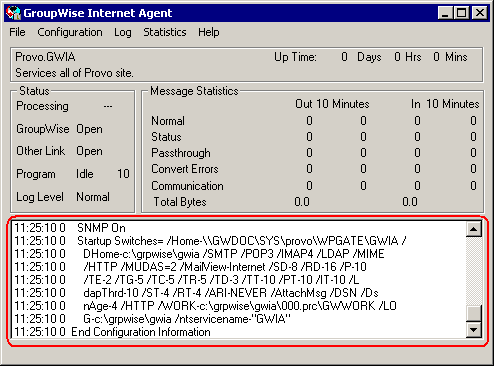
Menu Functions
The following sections explain the menu options available in the Internet Agent console:
NetWare Internet Agent Console
The menu functions on the NetWare Internet Agent console provide you with the following options.
F6-Restart: Select this option to restart the Internet Agent. The Internet Agent will reread all of its configuration files (gwia.cfg, blocked.txt, gwauth.cfg, route.cfg, and so forth).
F7-Exit: Select this option to terminate the Internet Agent and return to the system prompt.
F8-Info: Select this option to display the Internet Agent configuration information in the Logging section of the console and in the log file.
F9-Browse Log File: Select this option to browse the log file. The following browse options are displayed:
F1-Cancel Browse: Select this option to exit browse mode and to return to the console.
F2-Search Log: Select this option to search for a text string within the log file.
Up-arrow, Down-arrow: Press the Up-arrow and Down-arrow keys to scroll one line at a time.
PgUp, PgDn: Press the Page Up and Page Down keys to scroll one screen at a time.
H, H, Up-Arrow: Press Home, Home, and the Up-arrow to move to the top of the log file.
H, H, Down-Arrow: Press Home, Home, and the Down-arrow to move to the bottom of the log file.
F-10 Options: Select this option to display the options menu. The following options are displayed:
F1-Exit Options: Select this option to return to the main Internet Agent console screen.
F2-Log Level: Select this option to toggle between log levels. This option overrides the default log level set in the Log Settings page (Internet Agent object > GroupWise tab > Log Settings page) or the /loglevel switch in the startup file for the current session.
F6-Colors: Select this option to scroll through the several color options. This option is useful if the Internet Agent station has a monochrome monitor. You can also use this option to help you quickly identify an Internet Agent if more than one is running.
F8-Zero Stats: Select this option to reset the values in the Statistics section of the screen.
F9-Stats: Select this option to scroll through the SMTP service statistics, POP service statistics, IMAP service statistics, and LDAP service statistics.
Windows Internet Agent Console
The menu functions on the Windows Internet Agent console provide you with the following options.
File > Restart (F6): Select this option to restart the Internet Agent. The Internet Agent will reread all of its configuration files (gwia.cfg, blocked.txt, gwauth.cfg, route.cfg and so forth).
File > Exit (F7): Select this option to terminate the Internet Agent and return to the system prompt.
Configuration > Agent Settings (F5): Select this option to display the Internet Agent configuration information.
Configuration > Edit Startup File: Select this option to open the gwia.cfg file in the default text editor.
Log > Cycle Log: Select this option to close the current log file and start a new one.
Log > View Log: Select this option to view the log files.
Log > Log Settings: Select this option to set the logging level, turn on or off disk logging, and configure the maximum log file size and disk space. These changes apply only to the current session.
Statistics > Message: Select this option to display the Message statistics. For information about the Message statistics, see Message Statistics.
Statistics > SMTP Service: Select this option to display the SMTP Service statistics. For information about the SMTP Service statistics, see SMTP Service Statistics.
Statistics > POP Service: Select this option to display the POP Service statistics. For information about the POP Service statistics, see POP Service Statistics.
Statistics > IMAP Service: Select this option to display the IMAP Service statistics. For information about the IMAP Service statistics, see IMAP Service Statistics.
Statistics > LDAP Service: Select this option to display the LDAP Service statistics. For information about the LDAP Service statistics, see LDAP Service Statistics.
Statistics > Zero Statistics (F8): Select this option to reset the Message, SMTP, POP, IMAP, and LDAP statistics.